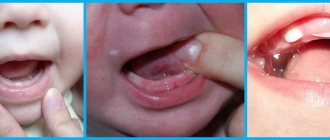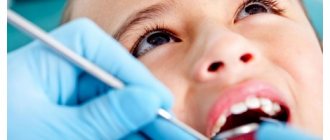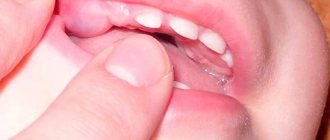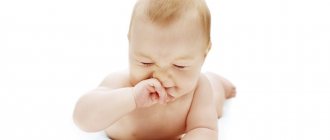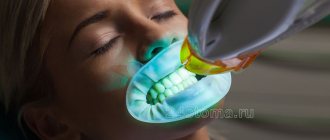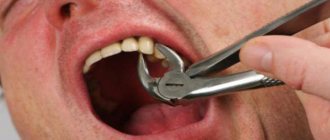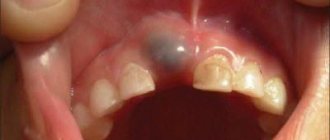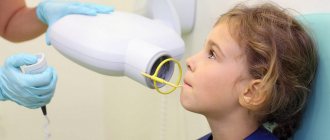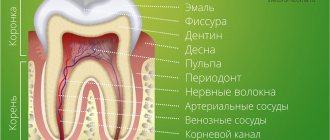The period when a baby's baby teeth erupt is both exciting and difficult for both the child and his parents. Children are often capricious during this period, sleep poorly, cry, and all because the appearance of their first teeth is accompanied by unpleasant sensations. Since the child himself cannot tell his parents about his problem and always reacts the same way to any type of discomfort, it is difficult for mom and dad to differentiate the signs of teething under the child’s behavior.
In this article, especially for young parents, we have collected as much useful information as possible about the eruption of baby and permanent teeth in children, so that you understand what is happening and how to act in this situation to help the baby.
How teeth are formed
The appearance of the first tooth is a milestone in a child's development. Now he's almost an adult! After all, his teeth will help him chew solid food and develop speech.
Baby teeth begin to form in the fetus as early as the 6th week of pregnancy. Between the 3rd and 6th months, enamel has already formed on the teeth. All this will be hidden under the gums for the time being. At the same time, deep in the jaw bone there are already the rudiments of molar teeth.
For most children, their first tooth appears between 4 and 7 months, but for some it happens later. With early development, it can erupt at 3 months or earlier. If the child grows normally and has no problems with skin and hair, then it’s okay. But if your baby is already 1.5 years old, and teeth have not appeared, you may need the help of a dentist.
The lower teeth usually appear about a month earlier than the upper teeth.
Approximate order of appearance of baby teeth:
- Lower central incisors (at 6 – 7 months).
- Upper central incisors (at 8 – 9 months).
- Upper lateral incisors (at 9–11 months).
- Lower lateral incisors (at 11 – 13 months).
- Upper small molars (molars) (at 12 – 15 months).
- Lower small molars (molars) (at 12 – 15 months).
- Upper canines (at 16 – 18 months).
- Lower canines (at 18 – 20 months).
- Lower large molars (molars) (at 24 – 30 months).
- Upper large (root) (at 23 – 30 months).
By age 3, your baby should have all 20 teeth, which will last until he is about 6 years old, when his first baby tooth falls out.
Don't be discouraged if your teeth grow crooked at first. Over time they will all fall into place.
The appearance of the first teeth is a natural physiological process, which at the same time can become a real test not only for the baby, but also for his parents. In many ways, the child’s condition at this moment depends on the positive attitude, support and attention from the parents. However, we should not forget about the whole arsenal of remedies that will help alleviate the unpleasant symptoms of teething and make this stage in life less exciting and painful.
Crying, whims, increased body temperature, lack of appetite, sleepless nights - all these are constant attributes of the period of dentition (teething) in children. Teething is a natural physiological process that begins at the age of 4-7 months and ends by 3 years, when All 20 baby teeth erupt. Despite the experience of generations, in reality, very few parents know what actually needs to be done to make life as easy as possible for both the baby and themselves.
You can recognize the imminent appearance of a baby tooth by the presence of characteristic signs:
The baby's gums become swollen and salivation increases - typically 4 days before the tooth erupts, on the day of teething, and 3 days after, leading to this 8-day window being called the "teething period".[1]
The child makes intense chewing movements with his gums, trying to get rid of the obsessive itching.
Often, children have a runny nose during the dental period. Nasal discharge and a rare wet cough during teething last no more than 3-5 days and are associated with increased mucus secretion and accumulation of saliva in the upper respiratory tract.
Fever during teething can last 1-2 days, and the child’s body temperature does not exceed 37.4-38⁰C. It is caused by the release of biologically active substances in the teeth growth zone and subsides on its own soon after eruption. However, if the child’s body temperature is above 38⁰C or lasts more than 2 days, you should consult a doctor.
Low-grade body temperature (37-38°C) in children SHOULD NOT be reduced with medication. If your baby's body temperature is above 38°C or lasts more than two days, consult a doctor immediately to rule out infection!
Digestive disorders and loss of appetite are also associated with a large volume of saliva secreted, which stimulates intestinal motility.
The child may become restless and irritable.
How to help your baby when teething
:
. At this moment, surround the child with care and affection - pick him up more often or rock him, thereby calming him down.
For itchy gums, use rubber teethers with liquid contents inside. Pay attention to the composition of the product - it should not contain bisphenol A, latex, PVC, phthalates.
Teethers ease the baby's discomfort from the appearance of the first baby teeth, develop thinking, concentrate attention, and improve fine motor skills of the fingers. Use safe “freezing” - before giving the teether to the child, place the
product in the refrigerator for an hour.
If you have already started feeding your baby, use nibblers (a silicone or mesh container with holes in which chewable foods are placed inside), or offer your baby chilled baby puree, yogurt, etc.
Try to learn a few simple techniques for massaging the gums with your finger to further help your child cope with the painful process of dental treatment.
Focus on safety
With all the introductions, it is, as a rule, almost impossible to overcome the pronounced painful symptoms during teething in a child without taking special medications. To help your baby without risking his health, you must follow the recommendations of your pediatrician. In this case, the choice should be made exclusively in favor of natural and safe products.
To alleviate the baby's condition during teething, parents quite often turn to dental gels based on local anesthetics (lidocaine, benzocaine, choline salicylate), unaware of the possible risks.
Local painkillers in gels have a short-term effect (no more than 1 hour), after which the pain returns. Trying to help their child, parents use gels more often than the safe dosing regimen allows. The natural result of excessive use of dental gels in infants is rapidly increasing intoxication, which can manifest itself as life-threatening symptoms, such as impaired breathing, swallowing, heart rhythm, etc.[2][3]
The Food and Drug Administration (FDA) in the United States opposes the use of lidocaine gels[4] for painful teething in children, warning of the risk of serious side effects.
The FDA has also banned the use of benzoin-based gels for teething in children.[5]
Such local anesthetic drugs numb the child’s gums for 10–20 minutes (in the oral cavity they are washed off with saliva and swallowed by the child), and the risks of their use outweigh the potential effect.
To help your baby without risking his health, you must follow the recommendations of your pediatrician. In this case, the choice should be made exclusively in favor of natural and safe products.
An oral solution based on medicinal plants (chamomile, laconosa, rhubarb) ─ Dantinorm Baby ─ is available in the form of individual dosed containers. Each container contains one 1 ml dose of a sterile solution of the drug, which can be easily dropped into the baby's mouth.
Unlike pain-relieving gels, the effect of Dantinorm Baby begins on average in 10 minutes and lasts on average 8 hours, which, when taken 3 times a day, protects the baby from teething symptoms 24 hours a day.[6] Over the many years of use of Dantinorm Baby throughout the world, not a single case of drug overdose has been reported and there have been no reports of side effects associated with its use.[7]
To date, Dantinorm Baby is the only drug used without restrictions for teething in infants, approved by the Russian Dental Association.
Expert opinion: Larisa Kiselnikova, head of the Department of Pediatric Dentistry, Moscow State Medical University named after. Evdokimova, chief freelance pediatric dentist in the Central Federal District of the Russian Ministry of Health.
“The Dental Association of Russia (StAR) constantly monitors the quality of products and medical products used in dental practice. In 2022, a special commission of StAR conducted an expert assessment of the documentation and analyzed foreign and Russian experience in using Dantinorm Baby. Based on the results of the inspection, the commission confirmed its high efficiency and safety.”
[1] Study Macknin ML, Piedmonte M, Jacobs J, Skibinski C. Symptoms associated with infant teething: a prospective study. Pediatrics. 2000: p. 747-752.
[2]Williams, Gary D., et al. "Salicylate intoxication from teething gel in infancy." Med J Aust 194.3 (2011): 146-8.
[3] https://www.gastroscan.ru/literature/authors/7390
[4]https://www.fda.gov/drugs/drug-safety-and-availability/fda-drug-safety-communication-fda-recommends-not-using-lidocaine-treat-teething-pain-and-requires #:~:text=In%20addition%20to%20causing%20death,or%20it%20is%20accidentally%20swallowed.
[5]https://www.fda.gov/news-events/press-announcements/fda-takes-action-against-use-otc-benzocaine-teething-products-due-serious-safety-risk-lack-benefit
[6] Kazyukova T.V., Ilyenko L.I., Kotlukov V.K. Duration and effectiveness of various medications for pathological symptoms of dentition in infants. Pediatrics. 2019; 98 (2): 133-140.
[7] Instructions for the drug Dantinorm Baby.
How to understand that your baby is teething (symptoms)
Many people believe that the process of teething must necessarily be accompanied by general anxiety of the baby, fever and diarrhea. However, not all experts share this point of view. Some consider this a mere coincidence. There is an opinion that children, when they start teething, are more likely to put dirty objects in their mouths to scratch their gums, and cause an infection.
Some lucky people go through this period painlessly.
But most children still experience some discomfort:
- Anxiety;
- Increased salivation, which can lead to facial irritation;
- The gums swell and become more sensitive;
- Refusal to eat;
- Bad dream.
If your baby has a fever or diarrhea, consult a doctor.
What affects the timing of teething?
Processes in the body are individual, including timing. The age at which the first teeth appear is determined by a number of factors:
- Heredity.
- The intrauterine period and negative factors affecting the fetus (for example, a pregnant woman taking certain medications).
- Nutrition for the expectant mother during the period of waiting for the baby and breastfeeding.
Introduction of complementary foods, etc.
How to help your baby when teething
- Give your baby something to chew on, such as a teether, which can be pre-chilled in the refrigerator.
- Massage your baby's gums with a clean finger. You can first wrap your finger in clean gauze. This will relieve the pain for a while.
- If your baby is already eating solids, give him cool foods (applesauce or yogurt).
- You can give your child something hard to chew on, such as a cracker. Just make sure your baby doesn't choke.
- If all of the above does not help, you can give your child a baby pain reliever or a special teething gel - strictly after consulting a doctor.
Vomiting, runny nose and diarrhea are not always symptoms of teething. If your baby appears unwell, call the doctor.
Possible complications
"Surprises"
The problems that nature presents when infants have their first teeth do not end with the listed troubles. Sometimes other complications are possible:
- Formation of hematomas.
A bluish-colored bubble swells on the gum. Most often it resolves over time, but sometimes if the blister is too large, surgery is required. The doctor makes a small incision on the gum to remove the bloody fluid.
- The appearance of vomiting.
This may be caused by excessive salivation. However, if vomiting is accompanied by diarrhea and fever, these may be signs of rotavirus, so it is necessary to urgently show the child to the pediatrician.
- Cough reflex.
With normal teething it does not happen. The cause of the cough may be excessive saliva secretion, which causes the baby to choke.
If a runny nose appears, take your child to the doctor
- teething probably coincided with a cold.
Important:
If your baby is experiencing fever, diarrhea and vomiting during teething, take this seriously. The cause of their appearance cannot be teething. It is urgent to call a pediatrician, since the baby’s body is at risk of intoxication due to a developing infection.
Choosing a toothpaste and brush
Has your baby cut his first tooth? Congratulations!
- Until one year of age, parents need to brush their baby’s teeth without toothpaste using a special silicone brush placed on their finger at least once a day.
- At one year old, the baby needs to pick up his first children's toothbrush - without toothpaste for now. It is better if the child chooses it himself. She should interest him, but not scare him away.
What should you pay attention to when choosing a children's toothbrush?
- Decor - kids love bright colors and funny characters.
- The handle should be comfortable, preferably made of non-slip material with a protective ring to avoid injury. Its length should correspond to the age of the child.
- It is important that the brush head is not too large and awkward. The optimal size is 2–3 teeth of a child. To avoid damaging your gums, it is better to choose a brush with a rounded head.
- Soft brushes with a bristle height of no more than 11 mm are suitable for children. It should be even so that the pressure on the surface of the teeth is uniform.
- From 2 to 2.5 years old, it’s time to start using toothpaste and teach your child to brush his teeth on his own. You need to choose a special baby toothpaste without fluoride, because the baby may want to eat it. You can switch to fluoride toothpaste when he learns not to swallow it.
What are the complications, and when to see a doctor?
| Symptom | Teeth are being cut, there is no need to go to the pediatrician | The disease develops, contact your pediatrician |
| Cough | A coughing attack begins due to excess salivation. The cough is wet and infrequent. | The cough gets worse, does not go away, does not allow the baby to sleep, and prevents him from eating. Doesn't stop for more than 2 days. Breathe heavily. |
| Nasal discharge | Nasal discharge is transparent and watery and disappears by the 4th day. | The runny nose does not go away for the 4th day. Lots of yellow or green discharge. |
| Heat | The temperature does not exceed 38 °C and lasts no more than 2-3 days. Rapidly decreases under the influence of antipyretics. | Fever above 38.5 °C for more than 2 days. Signs of a cold appear (severe cough and runny nose). |
| Loose stools | Lasts less than 72 hours. | Lasts more than 72 hours. |
| Changes in the oral cavity | The gums become swollen and red. | The oral mucosa is covered with white plaque or ulcers. |
How to brush your teeth correctly
- Your baby's teeth need to be brushed 2 times a day - in the morning and in the evening before bed.
- Use a small amount of toothpaste at first, about the size of a grain of rice, then work up to a pea-sized amount.
- If you use such a small amount of toothpaste, there is no need to rinse your mouth.
- Brush your teeth gently from the outside and inside.
- The tongue also needs to be cleaned, because bacteria accumulate on it, causing bad breath.
- Remember to change your toothbrush every 3 months.
At this stage, it is too early to floss because the teeth are usually far apart.
What can be done to help a child with severe itching and pain?
- Carry your baby in your arms more often, play with him and distract him.
- Give chilled water in a bottle, cool fruit puree or kefir. The main thing is that the liquid is not too cold, otherwise the baby will catch a cold.
- Massage the gums with a special silicone brush (see picture above) or you can gently use your clean finger.
- Buy your baby a teether and let's chew.
Such devices are made from plastic, rubber, silicone, wood, or a combination of different materials. The surface of the toys should be elastic and uneven to make it easier for the child to scratch the gums. A cooled teether relieves itching better, so it can be placed in the refrigerator to cool for 10-15 minutes. But don't chill it in the freezer!
- Do not use gum gels with lidocaine and benzocaine.
The child has a lot of saliva in the mouth, so gels are not effective during this period. The child swallows most of the gel.
Creating a good habit
The habit of brushing your teeth should be established in childhood. If you don’t force your child, but figure out how to turn this activity into an interesting game, your baby will brush his teeth with pleasure. Here are some tips:
- Children love to copy adults, so lead by example by brushing your teeth with your child.
- If you brush your teeth with your baby, at the end open your mouth and show each other how you handled this “task.” If necessary, clean your child's teeth yourself.
- Don't scold him, no matter how badly he cleaned it. Children at this age have not yet developed fine motor skills, so do not expect precise movements from them.
- Let your child associate brushing his teeth with something joyful. Play his favorite children's music, tell him stories about teeth, and draw on a dental theme.
- Keep a piece of paper with a schedule for brushing your teeth. Divide the day into morning and evening (you can draw the sun and moon there) and check the box when you brush your teeth.
- Finally, talk to your child like an adult. Explain to him why brushing his teeth is good. Draw scary microbes on a piece of paper and together figure out how you can fight them.
If your little one refuses to brush his teeth, try buying him a new toothbrush with his favorite cartoon character on it. Get him interested. Get several toothbrushes and let him choose a new one each time.
The first "bells"
The first signs of rapid teething are quite vague, but after observing the child for several days, you can notice changes in his well-being and behavior. Most babies begin to act restless, wake up more often at night, and eat less milk or formula about 4 weeks before the central incisors (these teeth appear first in children) erupt.
During this period, behavioral changes can be noted, listed in the table below.
Table. Changes in behavior during teething.
| Action | Why does the child behave this way? |
| This is explained by severe itching in the place where the tooth should appear: the top of the tooth rests on the gum, trying to break through the mucous tissue, and injures it, causing severe irritation. | |
| Such behavioral changes are especially pronounced in breastfed children due to stronger emotional contact with their mother. For an infant, the breast is not only a source of food, but also a means of comfort, therefore, when experiencing pain and discomfort, the child instinctively looks for an object that he associates with positive emotions. For bottle-fed babies or mixed-fed babies, this item can be a bottle of milk or a pacifier. | |
| The explanation for the temporary refusal of foods introduced into the children's diet is due to physical discomfort and unpleasant sensations when the gums touch a spoon or other cutlery. If you give your child a raw apple or carrot during this period, most likely he will try to chew them with pleasure, since such movements provide gum massage and help soothe pain. This method must be used strictly under adult supervision due to the risk of accidental inhalation of small pieces! |
Changes during this period also affect children's sleep. Most babies fall asleep well, but begin to wake up frequently at night to breastfeed. It is impossible to fight this phenomenon - sleep returns to normal after the eruption of the frontal incisors and canines, which are the most painful. To relieve pain, you can use special gels with analgesic properties, for example, “Kamistad Baby” or “Kalgel”. They will also help reduce inflammation caused by trauma to the gums from the sharp tip of an erupting tooth.
Important! If during a night's sleep a child wakes up too often, cannot fall asleep for a long time, and each rise is accompanied by a bout of severe crying, it is necessary to consult a doctor to rule out pathologies of the digestive system and other internal organs.
What microelements are needed for teeth growth?
Fluorine
Fluoride strengthens tooth enamel, making it more resistant to acids and harmful bacteria. Thus, it helps prevent the development of caries.
Fluorine is found in:
- Toothpaste - however, remember that toothpaste with a small fluoride content can only be used by children over 4 years old;
- Fluoride-enriched water;
- Chewable tablets or drops;
- Some fruit juices.
Remember that too much fluoride can lead to fluorosis, which is when white spots appear on the teeth. Therefore, it is important not to use too much toothpaste, especially if the child has not yet learned to spit it out.
Calcium
Calcium takes an active part in the mineralization of teeth. A 3-year-old child should receive 800–1100 mg of calcium per day.
Products containing calcium:
- Milk, yogurt;
- Spinach and other green leafy vegetables;
- Broccoli;
- Fish.
In order for calcium to be better absorbed, it needs helpers. One is vitamin D and the other is vitamin K2.
Vitamin K
Calcium is collected and transported into bone tissue using the protein osteocalcin, which normally “dormants” peacefully in the blood. In order to activate it, you need natural vitamin K. It is found in dairy products (milk, yogurt, kefir, cottage cheese - for example, Agusha K2 cottage cheese).
Why do teeth erupt with irregularities?
The condition of a child’s teeth in the first years of life depends on the health of the mother during pregnancy. The formation of hard dental tissues may be disrupted if a woman:
- suffered from toxicosis at the initial stage of pregnancy;
- experienced severe prolonged stress;
- was treated for kidney disease;
- suffered from rubella.
In addition to maternal diseases, the maturation of teeth and the development of the jaw system can be affected by:
- fetal prematurity or, conversely, delayed birth;
- conflict of Rh factors;
- sepsis suffered by a child in the first month of life;
- frequent colds, pneumonia;
- convulsions;
- toxicosis;
- refusal to breastfeed.
Often, parents, driven by the best intentions, want to alleviate the baby’s suffering by giving him medications. You must understand that any medicine, even if it seems completely safe, cannot be taken without consulting a pediatrician!
When should I take my child to the dentist?
The Ministry of Health of the Russian Federation recommends showing a child to the dentist once a year starting from 12 months.
The purpose of the first trip to the dentist is prevention. The doctor checks whether teeth are growing correctly and gives recommendations on oral hygiene. It is better to do this no later than your first birthday, so that the specialist does not miss caries and possible problems with your bite.
The first trip to the dentist should not frighten your child.
Here are some tips to make it painless:
- Do not pay too much attention to this event, do not prepare your child on purpose;
- Don’t worry yourself so that your baby doesn’t get nervous along with you;
- If possible, arrive early to your appointment to give your baby time to look around.
When to sound the alarm
Attentive attitude to the child during the development of masticatory organs will help not to miss pathologies. Private pediatric dentistry can identify diseases in the early stages and, if necessary, provide assistance. You should start visiting a pediatric dentist at 5-6 months, when the first teeth appear. A pathological process may be indicated by:
- Failures in the formation of primary and mammary units, their irregular shape, unnatural color and size;
- Eruption of incisors, canines and molars outside the dentition;
- Absence of most units after 3 years.
Consulting a doctor and diagnostic tests will reveal the problem. It is important to monitor not only the location of each unit, but also record their color. If the incisor has a black edge, there is an inflammatory process in the body. With a greenish-yellowish color, disturbances in the metabolic processes of bilirubin or the death of red blood cells are diagnosed. The brown color appears after long-term use of antibiotics. A reddish tint indicates congenital disorders in the metabolism of pigment such as porphyria.
Thin and soft enamel requires special care. Dentists recommend using a specific fingertip. It does not have a smooth surface, but with pimples. It is not advisable to use toothpaste at this age. Regular visits to the dentist and preventive measures will ensure that the units erupt without complications.
